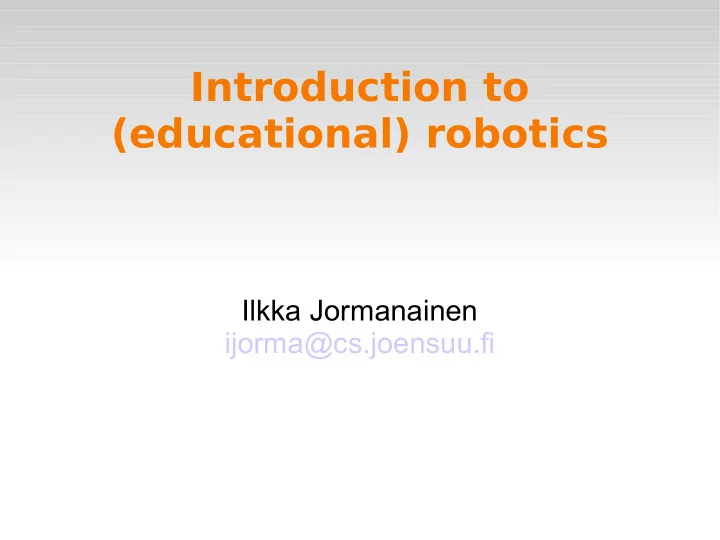

Introduction to (educational) robotics Ilkka Jormanainen ijorma@cs.joensuu.fi
Robots ”robota”: mechanical or forced labour Artificial ”life” created by a human (“robots”) has existed throughout history (eg. Golem in Jewish folklore) Robots are very famous in popular culture Sci-Fi movies Terminator Star Wars, A.I, I – Robot, ...
What is robot? Artificial life, that is, imitating living creatures Walking humanoid robots Flying nano-robots Snake-like rescue robots Mechanical device which can react for the stimulus coming from the surrounding environment Moving, manipulation of the environment
What is robot? Precise definition is rather hard Autonomous working Virtual robots? From technical point of view: Programmability Mechanical capabilities Flexibility
The 1940 Laws of Robotics First Law: A robot may not injure a human being, or, through inaction, allow a human being to come to harm. Second Law: A robot must obey orders given it by human beings, except where such orders would conflict with the First Law. Third Law: A robot must protect its own existence as long as such protection does not conflict with the First or Second Law.
Structure of robot Sensors Information collection Touch sensor, radar, microphone, IR sensor, temperature, rotation sensor, GPS, ... Actuators Motors, wheels, belts, propels, ... metamorphosis
Structure of robot Processing Sensor information Controlling the actuators Data storing and manipulation Can be internal or external
Structure of robot Communication Communication between processing unit and sensors/actuators Communication between robots Communication between user and robot Robot's internal state Delivering of collected information External data processing
Usage of robots Mechanical tasks in factories and logistic centers Dangerous (for humans) tasks Rescue tasks, military operations Entertainment Sony Aibo House holding Vacuum cleaner
Usage of robots Social robots Educational robotics Lego Mindstorms
Educational robotics Same principles apply also for educational robots Motivation for students Successful and unsuccessful teaching experiments Cheap price and flexibility are crucial More about educational robotics on the next time Pedagogical and technical issues A crash course in how to use Lego Mindstorms
A group task Form a group of x students Check some of the links at the course web page and think how (educational) robotics could be applied in the courses you have been studying in our department (15 mins) Short presentations (5 mins) for rest of us What course(s)? How to apply? What techniques to use?
First individual task Based on the materials and discussion in the lecture, write a short (~1 page) essay about what kind of robot you dream about. What the robot should do? What it shouldn't do? What are the main challenges when implementing such a robot? Return your writing to ijorma@cs.joensuu.fi by 1 November, 8am with email subject “IMPTECH: Task 1” Feedback will be provided
Recommend
More recommend